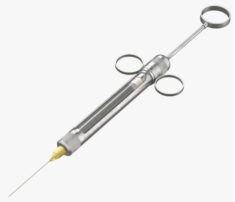Here’s a fact you can sink your teeth into: the dental industry has historically been one of the leading customers of plastic.
Why?
The answer is easy: because they go through such huge amounts of supplies, most of which quickly becomes contaminated with blood, saliva and other bodily fluids, dental offices are forced to rely on single-use plastic dental devices for hygienic reasons. And plastic injection molding has always been one of the fastest and most cost-effective ways to manufacture these dental supplies. Though there are metal alternatives, and many dental devices are partially made of metal, nothing quite outmatches the efficacy and flexibility that plastic polymers provide.
These days, a “plastic-less” dental clinic is simply inconceivable. Herewith, a primer on the seven most popular plastic dental products!

Plastic Dental Syringes
Unlike medical syringes, dental syringes are designed to inject analgesics into the gums surrounding the teeth that are being treated. This is critical for some very invasive, if not brutal, dental procedures that involve such processes as drilling into the jaw.
Plastic Dental Forceps
Plastic forceps are designed to grip small items such as wedges, matrix bands, cotton balls and gingival retraction cords. The “business end” of these forceps should be sharp enough to cut teeth and roots but “soft” enough to be warm and easy to grip by the dentist. That’s why they’re often made of plastic.
Plastic Disposable Dental Explorers
Dental explorers are used to examine a tooth for defects such as tartar, calculus and cavities. The thin, sharp tips are designed for pinpoint accuracy in the mouth. Dental explorers can also be used to remove debris such as tooth chips. These dental explorers come in many different configurations, each with a specific role to play.
Plastic Disposable Dental Mirrors
Dental mirrors have three basic uses:
- They give the dentist an indirect view of the patient’s mouth. It helps with some procedures on the top part of the mouth, or somewhere deeper inside
- Mirrors can also be used to bring in some light into some parts of your mouth unreachable by direct outside light
- Finally, dental mirrors can be used to retract some soft tissues, particularly those that don’t need that much force
Plastic Amalgam Carriers
Amalgam carriers transport freshly prepared restorative materials. When the lever on the top of the carrier is depressed, the amalgam is injected directly into the cavity.
Though simply designed, amalgam carriers often can be very hard to use, particularly when dental personnel have done a poor job packing the carrier with amalgam. This can result in the amalgam falling out before it is ejected. Dentists should always empty the amalgam carrier. If the solution hardens within the carrier, it will have to be thrown out.
Plastic Mouth Props
Dentists use these wedge-shaped bite blocks to help patients that have difficulty keeping their mouths open wide during treatment. Bite blocks are most often used on children, and people who are sedated.
Plastic Dental Trays
Although rather prosaic, dental trays are nonetheless an indispensable item in a dental office. Dental trays are typically made through plastic injection molding to ensure that all equipment can be secured in place. Many dentists use this because it makes their work station very clean and organized. Since the equipment is separated by depressions and plastic walls, dental trays can also prevent cross-contamination, keeping dental devices sterilized longer.
Bottom line
The dental industry simply couldn’t survive without the supplies produced by plastic dental device makers!